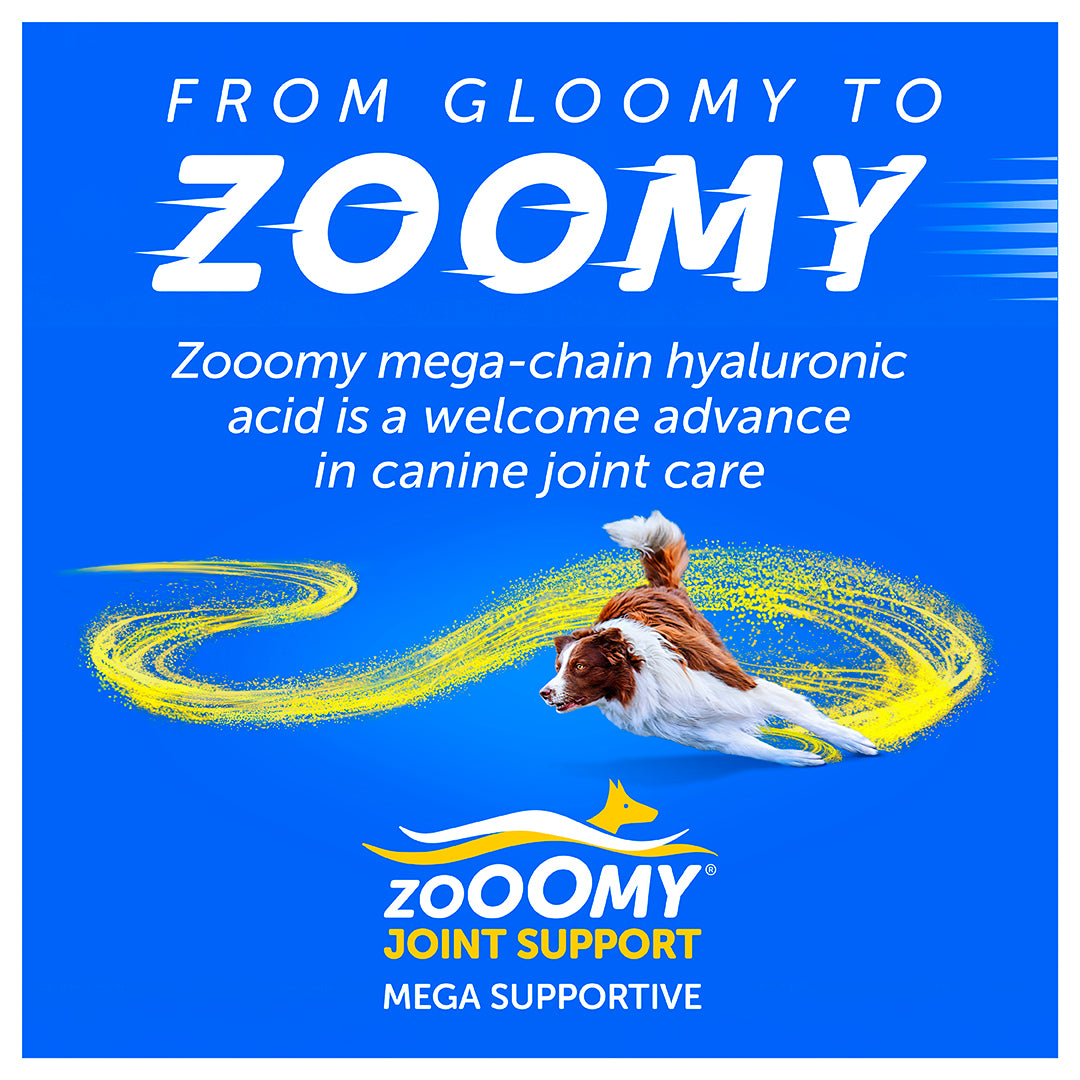If your dog has been diagnosed with hip dysplasia - or you're worried they might have it, this article may help! Hip dysplasia is one of the most common orthopaedic problems in dogs, and it can be heartbreaking to watch your best friend struggle.
The good news? With the right care, many dogs with hip dysplasia can still enjoy a full, happy life. So, what are the key things to remember about hip dysplasia in dogs?
If your dog is suffering from hip dysplasia, it is vital that you stay informed on:
- Causes: Understanding what causes hip dysplasia can help protect your dog from joint problems.
- Symptoms: Early identification of joint problems can help reduce their long-term impact.
- Diagnosis: Following expert advice after a diagnosis will ensure your dog experiences minimal discomfort.
- Typical Age: Hip and other joint problems become more likely at certain ages.
This vet-approved guide will walk you through what you need to know, from early signs to treatment options.
What is hip dysplasia in dogs?
Hip dysplasia is a genetic condition in which the collagen in the joint capsule of the hip joints doesn't develop properly. Instead of the joint being held together tightly by the capsule, the joint is loose and unstable. Over time, this laxity causes extra wear and tear, which can ultimately lead to painful arthritis.
In short, it’s a mechanical problem that becomes a degenerative one. And while medicines can help ease the resulting pain, they don't nourish or protect the joint itself. Supporting joint health early can help slow the cycle of damage.
Symptoms of hip dysplasia in dogs
Signs can vary depending on the severity of the joint's resulting malformation and your dog's age, but common symptoms include:
- Bunny-hopping gait (where both back legs move together)
- Stiffness or difficulty rising after rest
- Reluctance to run, jump, or climb stairs
- Swaying or "loose" movement in the hips
- Lameness or favouring one side
- Muscle loss in one or both back legs
Expert advice - Some dogs are stoic and hide pain, so trust your instincts if something feels ‘off.’
How to tell if your dog has hip dysplasia
Early diagnosis gives you more options for slowing the damage. Only a vet can diagnose hip dysplasia, through both a physical exam and X-rays. If you're seeing any of the symptoms above - especially in a susceptible breed - it’s worth getting them checked early.

Finding out your dog has hip dysplasia can be a worry, but it doesn’t always mean your dog will be in constant pain or need surgery. Every dog is different - some show only mild symptoms and live full, happy lives with simple management.
At what age does hip dysplasia appear in dogs?
Dogs as young as five or six months can show signs of hip dysplasia. Sometimes, it does not cause noticeable problems until they are middle-aged. Even in dogs with a genetic risk, other factors like weight, activity, and luck decide when signs may appear.

What causes hip dysplasia in dogs?
Genetics are the biggest factor followed by excessive body weight. If a dog's parents had hip dysplasia, there's a much higher risk. But environment plays a role too:
- Rapid growth (especially from overfeeding puppies)
- Obesity
- Excessive exercise at a young age
Breeding practices, nutrition, and early care all affect if a dog with hip dysplasia genes will develop overt clinical signs. If you’re feeling guilty, please know - hip dysplasia is often genetic and not something you could have prevented. Early support and good management can make a real difference to your dog’s comfort and long-term wellbeing.

Are certain breeds prone to hip dysplasia?
While any dog can develop hip dysplasia, it's especially common in larger breeds like:
- Labrador Retrievers
- German Shepherds
- Golden Retrievers
- Rottweilers
- Bernese Mountain Dogs
- Great Danes
That said, small dogs aren't immune - Pugs and French Bulldogs, for example, are increasingly being diagnosed.
Even if your dog is prone to hip dysplasia, regular gentle exercise is important. Keeping muscles strong helps support the joints and can reduce discomfort. Short, controlled walks are often better than long runs – but your vet can advise what's right for your individual dog.
Is it bad to walk a dog with hip dysplasia?
You can walk a dog with hip dysplasia, but it’s about balance. Regular gentle exercise is important to keep muscles strong and joints mobile. Short, frequent walks on soft surfaces are usually better than long, strenuous ones.
Avoid:
- High-impact activities like chasing balls, rough play, or jumping
- Slippery floors (use rugs or mats)
- Long hikes or forced exercise
Always watch your dog’s comfort levels and let them set the pace.
Support healthy joints with Zooomy: the long-chain hyaluronic acid supplement for dogsBrowse Here
How much does surgical hip dysplasia treatment for dogs cost?
Surgical options include total hip replacement and femoral head ostectomy (FHO). In the UK, these surgeries can cost between £2,000 and £6,000 for each hip. The price depends on the procedure and location. Surgery can be life-changing for some dogs - but it’s not always necessary. Many dogs are helped with a mix of pain relief, joint support, physical therapy, and easy changes at home.
What happens if hip dysplasia is left untreated?
Left untreated, hip dysplasia leads to progressive arthritis, chronic pain, reduced mobility, and loss of muscle mass. Eventually, quality of life can suffer significantly. But early intervention can massively slow this decline.
By combining pain management (like NSAIDs) with joint support supplements (like Zooomy’s rapidly-absorbed hyaluronic acid), weight control, and gentle physiotherapy, you can help your dog stay comfortable and mobile for years to come.
Owner’s guide following a hip dysplasia diagnosis
If your dog has just been diagnosed, here are some positive steps you can take today:
- Speak to your vet about pain relief and management options
- Introduce a high-quality joint supplement like Zooomy to nourish and protect their joints
- Make small changes at home like non-slip flooring, supportive beds, and ramps for cars or stairs
- Keep walks shorter but frequent to maintain muscle strength without overloading sore joints
- Monitor your dog’s movement and mood so you can spot any changes early.
How long can a dog live with hip dysplasia?
Dogs with hip dysplasia can live full, happy lives with the right management. Catching the condition early helps a lot. Supporting your dog's joints is important. Keeping your dog at a healthy weight matters too. Providing gentle exercise regularly makes a big difference.
Support your dog's hips with joint supplements from Zooomy
Zooomy isn’t a miracle cure, and we’d never claim it is. But it is a vet-developed, science-backed way to support joint comfort naturally.
Zooomy is made with high-quality long-chain hyaluronic acid and can help lubricate joints, reduce friction, and supports easier and happier movement.
If you want to help your dog feel more like themselves, this could be a good part of their pain management plan. Contact us today to learn more about supporting healthy joints for your dog with Zooomy supplements.
In conclusion
Hip dysplasia can feel daunting, but there’s so much you can do to help your dog stay comfortable and happy.
From joint-support supplements like Zooomy to easy changes you can make at home, small steps can make a big difference. Your dog’s best days aren’t behind them - they're still ahead.
Read Next:
How to choose a joint supplement for your dog?
Hyaluronic acid: why long chain is better than short chain
How does hyaluronic acid work?



